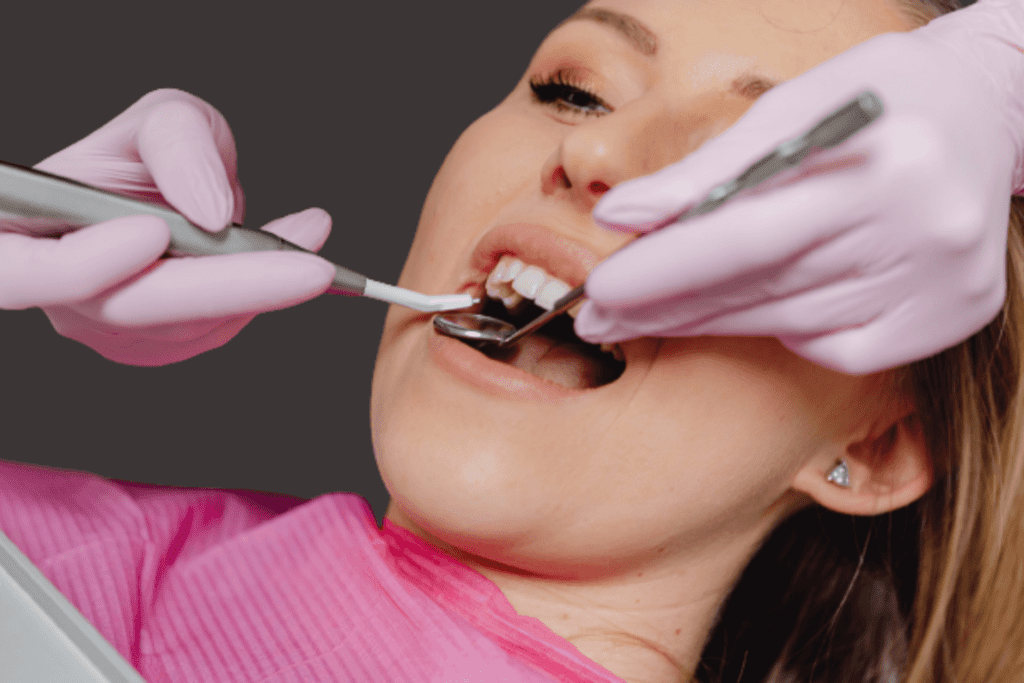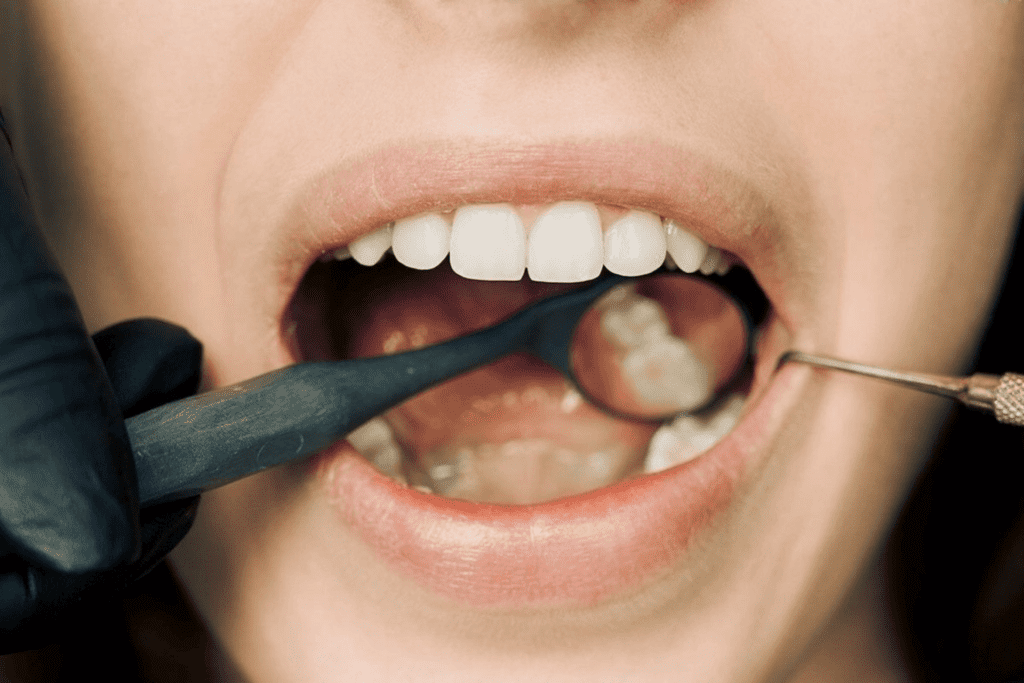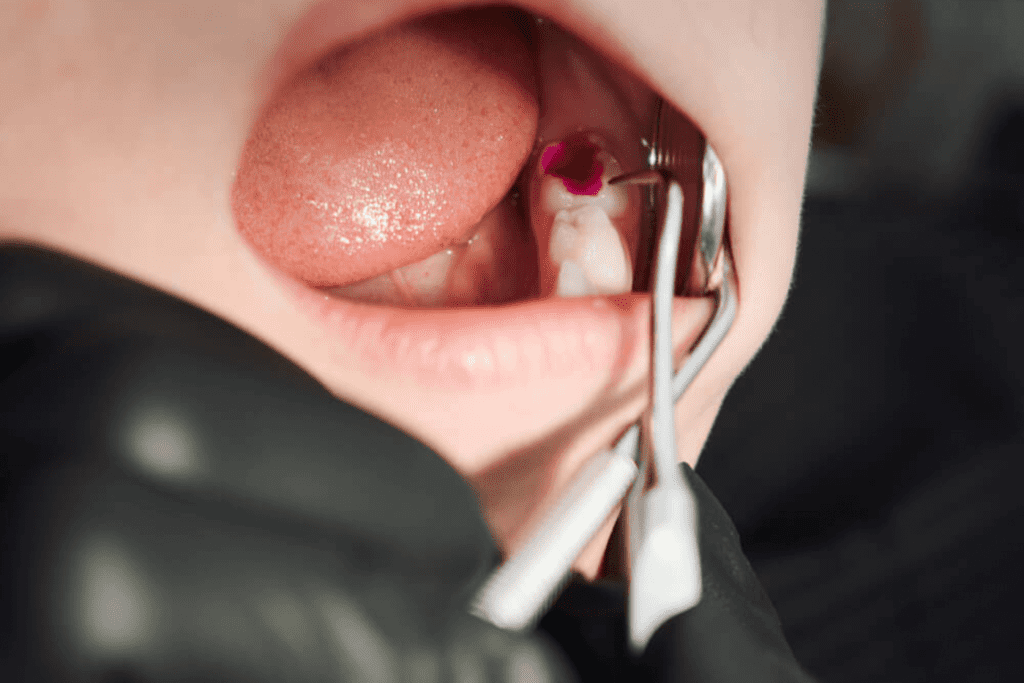Malocclusion is a dental condition characterized by the misalignment or incorrect positioning of the teeth when the jaws are closed. It refers to deviations from the normal arrangement of teeth, leading to issues with the bite, occlusion (how the upper and lower teeth fit together), and overall oral function.
Table of Contents
ToggleWhat is a Perfect Bite Alignment?
A perfect bite alignment, also known as an ideal occlusion, refers to the optimal alignment and relationship between the upper and lower teeth when the jaws are closed. In a proper bite alignment, the upper teeth slightly overlap the lower teeth vertically, with the back teeth fitting together stably and harmoniously.
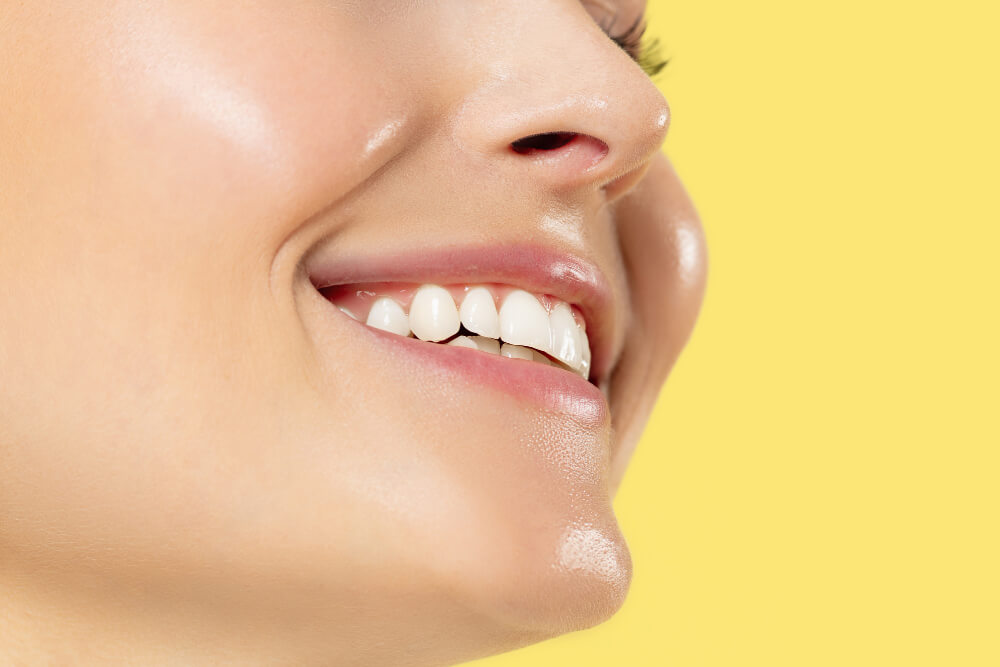
Key features of a proper bite alignment include:
Normal Overbite
The upper front teeth should vertically overlap the lower front teeth by a slight amount, typically around 2-4 millimeters.
Balanced Overjet
The upper front teeth should horizontally overlap the lower front teeth, with a minimal horizontal gap or overjet between them.
Correct Midline Alignment
The center of the upper front teeth should align with the center of the lower front teeth, resulting in a symmetrical appearance.
Proper Tooth Alignment
The teeth should be arranged in a regular arch form, without overcrowding or excessive spacing. Each tooth should have its appropriate position and angulation.
Stable and Comfortable Bite
The back teeth (premolars and molars) should fit together stably, with the cusps and grooves interlocking properly to provide effective chewing function.
Achieving a perfect bite alignment is important for several reasons:
Functional Efficiency:
A proper bite allows for effective and efficient chewing, biting, and speaking.
Dental Health:
It helps distribute forces evenly during chewing, preventing excessive stress on specific teeth or jaw joints, which can lead to tooth wear, fractures, and temporomandibular joint (TMJ) problems.
Aesthetics:
A proper bite alignment contributes to an attractive smile, with balanced proportions and harmony between the upper and lower teeth.
Causes of Malocclusion
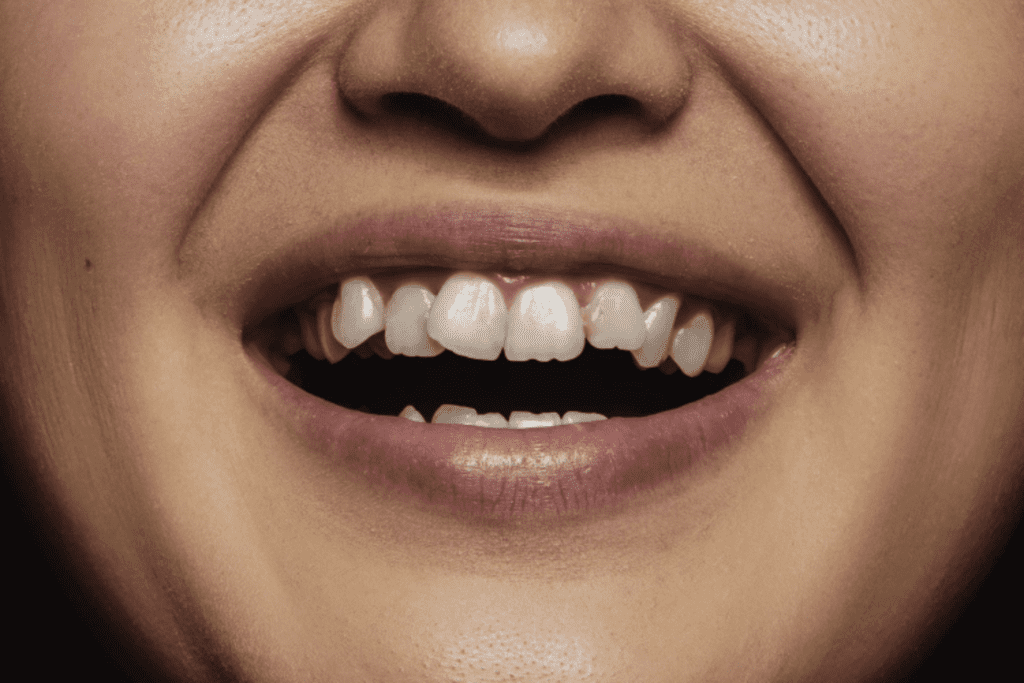
Malocclusion, or the misalignment of teeth and jaws, can be caused by various factors. Here are some common causes:
Genetic Factors
Genetic factors play a significant role in the development of teeth misalignment. Certain dental and jaw characteristics, such as the size and shape of teeth, jaw structure, and facial proportions, can be inherited from parents. If a family has a history of malocclusion or dental irregularities, there is a higher likelihood that an individual may also experience teeth misalignment.
Abnormal Jaw Development
Problems with jaw growth or development can contribute to teeth misalignment. This can include issues like an asymmetrical growth pattern of the upper and lower jaws, where one side grows more than the other, resulting in misalignment. Excessive or deficient jaw size, such as a small or recessed lower jaw (retrognathia) or an overly prominent upper jaw (prognathism), can also lead to malocclusion.
Tooth Irregularities
Irregularities in tooth size, shape, and positioning can lead to teeth misalignment. Overcrowding occurs when there is insufficient space in the jaw to accommodate all the teeth, causing them to become crowded or rotated. Missing teeth can cause adjacent teeth to shift and fill the gap, disrupting the alignment. Extra teeth (supernumerary teeth) can also lead to malocclusion. Additionally, abnormally shaped or sized teeth, such as unusually small or large teeth, can affect the alignment.
Prolonged Thumb Sucking or Pacifier Use
Sustained thumb sucking or prolonged pacifier use beyond a certain age can cause teeth misalignment. The repeated pressure from the thumb or pacifier can push the teeth and jaws out of their normal positions, resulting in misalignment. This is especially common when the habit persists as the permanent teeth begin to erupt.
Premature Tooth Loss
The early loss of baby teeth or permanent teeth can disrupt the normal alignment of teeth and create spaces. When teeth are lost prematurely, the adjacent teeth may shift or tilt into the space, affecting the overall bite and alignment. This can lead to malocclusion.
Dental Restorations or Fillings
Poorly placed dental restorations, such as crowns, bridges, or fillings, can affect the natural alignment of teeth. If the restoration is not properly contoured or positioned, it can cause misalignment or changes in bite relationships.
Oral Habits
Certain oral habits can contribute to teeth misalignment. Tongue thrusting, where the tongue pushes against the teeth during swallowing, can exert pressure and disrupt the alignment. Prolonged bottle feeding or excessive pacifier use can also impact tooth and jaw positioning, leading to malocclusion.
Trauma or Injury
Trauma or injury to the face or jaws can result in teeth misalignment. Fractures or dislocations of the jaws or significant dental trauma can cause misalignment of teeth and jaws, leading to teeth misalignment.
Malocclusion Symptoms

Malocclusion, or misalignment of the teeth and jaws, can present with various symptoms. Here are some common signs and symptoms associated with teeth misalignment:
Irregular Bite
One of the primary symptoms of teeth misalignment is an abnormal bite. This may include an overbite, where the upper front teeth excessively overlap the lower front teeth, or an underbite, where the lower teeth protrude beyond the upper teeth. Crossbite, where the upper and lower teeth do not meet properly when biting down, is another form of teeth misalignment.
Crowded or Crooked Teeth
Malocclusion often leads to overcrowding or crooked teeth. The teeth may appear misaligned, overlapping, or rotated due to insufficient space in the jaw for proper alignment.
Difficulty Chewing or Biting
Teeth misalignment can cause difficulty in biting or chewing food. Irregular tooth alignment can result in an uneven distribution of forces during biting, leading to discomfort or difficulty in effectively breaking down food.
Speech Difficulties
Some individuals with teeth misalignment may experience speech difficulties. The misalignment of teeth can affect tongue and lip movement, leading to speech impediments like lisping or difficulty pronouncing certain sounds.
Mouth Breathing
Teeth misalignment can contribute to mouth breathing rather than nasal breathing. This may occur due to a narrow dental arch, crowded teeth, or an abnormal jaw position, which can impede proper airflow through the nasal passages.
Excessive Tooth Wear
Misalignment of teeth can result in uneven forces during biting and chewing, leading to excessive wear on certain teeth. Over time, this can cause tooth enamel erosion, chipping, or sensitivity.
Temporomandibular Joint (TMJ) Disorders
Teeth misalignment can strain the jaw joints, leading to TMJ disorders. Symptoms may include jaw pain, clicking or popping sounds when opening or closing the mouth, headaches, or difficulty in fully opening or closing the mouth.
Facial Pain or Discomfort
In some cases, teeth misalignment can cause facial pain or discomfort. This can include pain in the jaw, temples, or surrounding muscles, which may be associated with jaw misalignment and muscle strain.
Diagnosis -Teeth Misalignment
The diagnosis of teeth misalignment typically involves a comprehensive dental examination by a dentist or orthodontist. Here’s an overview of the process:
Dental History
The dentist will begin by gathering information about your dental and medical history. They may ask questions about previous orthodontic treatment, dental habits, any symptoms you are experiencing, or any concerns you may have regarding your bite or tooth alignment.
Visual Examination
The dentist will visually assess your face, jaws, and teeth to look for any obvious signs of teeth misalignment. They will observe the position and alignment of the teeth, and the relationship between the upper and lower jaws, and assess for any irregularities or abnormalities.
Dental Impressions or Models
In some cases, the dentist may take dental impressions of your teeth or create models of your bite using dental putty or digital scanning technology. These impressions or models provide a more detailed representation of your teeth and jaw relationship, allowing for a more accurate assessment of teeth misalignment.
X-rays or Imaging
X-rays or other imaging techniques, such as panoramic X-rays or cone-beam computed tomography (CBCT), may be used to obtain a more comprehensive view of the teeth, jaws, and underlying structures. These images help in evaluating the position of the teeth, the relationship between the jaws, and identifying any abnormalities or impacted teeth.
Bite Analysis
The dentist or orthodontist will analyze your bite to assess how the upper and lower teeth come together. This involves evaluating the alignment of the teeth and assessing the overbite, overjet, crossbite, or other bite discrepancies that may be present.
Orthodontic Records
For more detailed analysis and treatment planning, additional orthodontic records may be taken. These may include extra-oral and intra-oral photographs, dental measurements, and dental models that are used to study and plan the appropriate treatment approach.
How Do You Get an Ideal Bite?
Fixing teeth misalignment and achieving an ideal bite typically involves orthodontic treatment. The specific approach will depend on the type and severity of the malocclusion. Here are some common methods used to correct teeth misalignment and achieve an ideal bite:
Braces
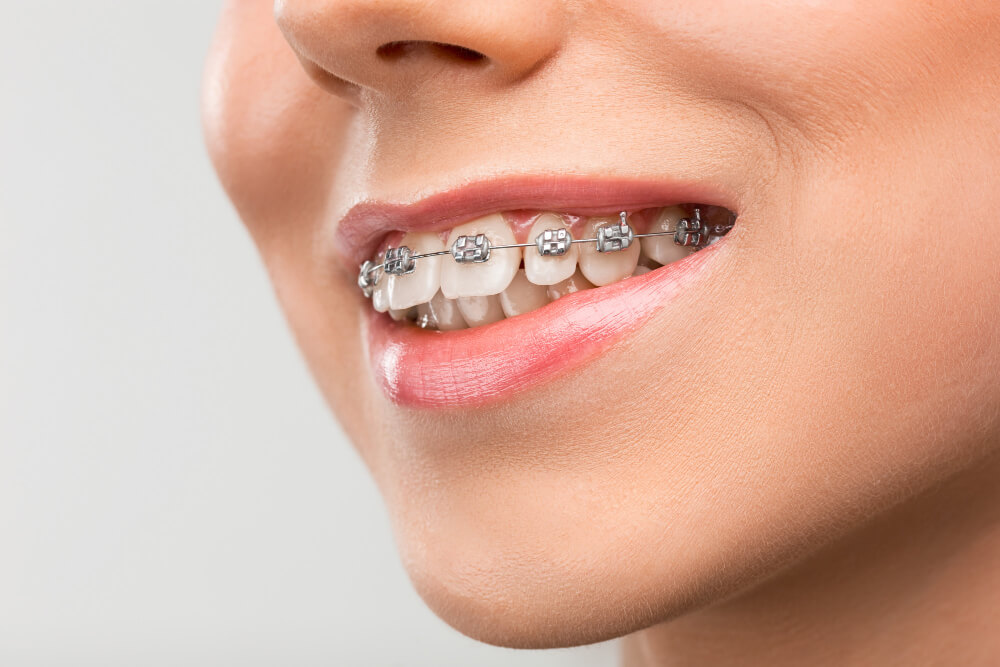
Traditional braces are a common orthodontic treatment method that involves attaching brackets to the teeth and connecting them with archwires. The orthodontist periodically adjusts the tension of the wires to apply gentle pressure, gradually shifting the teeth into their desired positions. Braces are effective in addressing a wide range of teeth misalignment issues, such as overcrowding, spacing irregularities, overbites, underbites, and crossbites.
Clear Aligners
Clear aligners, such as Invisalign, provide a popular alternative to traditional braces. These aligners are custom-made, transparent trays that gradually and gently guide the teeth into their desired alignment. Aligners are easily removable, allowing for convenient oral hygiene practices and the freedom to eat without restrictions. They are commonly used for treating mild to moderate cases of malocclusion, offering a discreet and comfortable option for individuals seeking orthodontic treatment.
Retainers
After braces or aligner treatment, retainers are often prescribed to maintain the corrected alignment of teeth. Retainers help prevent teeth from shifting back into their previous positions. They can be removable or fixed (bonded to the back of the teeth).
Tooth Extraction
In cases of severe overcrowding, tooth extraction may be necessary to create sufficient space for proper alignment. The decision to extract teeth depends on the individual’s specific dental condition and the recommendation of the orthodontist.
Orthognathic Surgery
For more severe teeth misalignment cases involving significant jaw discrepancies or skeletal issues, orthognathic surgery may be required. This surgical procedure aims to correct the underlying jaw alignment, often in combination with orthodontic treatment.
Other Orthodontic Appliances
In certain situations, additional orthodontic appliances, such as expanders (for correcting narrow dental arches) or headgear (to modify jaw growth), may be used in conjunction with braces or aligners to achieve an ideal bite.
Classes of Malocclusion
Malocclusion is classified into different classes based on the specific type and severity of the misalignment. The classification system most commonly used in dentistry is called the Angle’s Classification of Malocclusion, which categorizes malocclusion into three main classes: Class I, Class II, and Class III. Here’s an overview of each class:
Class I Malocclusion (Neutrocclusion)
Class I malocclusion is considered a normal or near-normal bite relationship. In this class, the molar relationship is correct, with the upper molars slightly overlapping the lower molars. However, there may still be other dental irregularities present, such as crowding, spacing, rotated teeth, or anterior crossbite (where the upper front teeth sit behind the lower front teeth).
Class II Malocclusion (Distocclusion)
Class II malocclusion is characterized by an overbite or a retruded (recessed) lower jaw, known as a retrognathic mandible. Class II malocclusion can be subdivided into two categories to provide more specific classifications.
Class II Division 1:
In this subtype, there is a significant overbite, where the upper front teeth significantly overlap the lower front teeth. The upper incisors may be protruded or stick out excessively, resulting in a “buck teeth” appearance.
Class II Division 2:
This subtype also involves an overbite, but the upper central incisors are retruded or inclined lingually (toward the tongue). The lateral incisors may be tipped outward, resulting in a more flattened or “squared” appearance of the upper front teeth.
Class II -malocclusion often requires orthodontic treatment, which may involve braces, aligners, or in some cases, orthodontic appliances combined with orthognathic surgery to correct the skeletal discrepancy.
Class III Malocclusion (Mesiocclusion)
Class III malocclusion is characterized by an underbite or prognathic (protruded) mandible. In this class, the lower jaw is positioned more forward compared to the upper jaw. This results in the lower front teeth protruding beyond the upper front teeth. Class III- malocclusion may require comprehensive orthodontic treatment, including braces, aligners, or in more severe cases, orthodontic treatment combined with orthognathic surgery to correct the jaw relationship.
It’s important to note that Angle’s Classification is a simplified categorization and there can be variations and complexities within each class of teeth misalignment. The classification helps in understanding the general pattern of misalignment and guides treatment planning. A thorough examination by an orthodontist or dentist is necessary to determine the specific class of malocclusion and develop an appropriate treatment approach based on individual needs.
Types of Malocclusion
Malocclusion refers to the misalignment or incorrect positioning of the teeth and jaws. There are several types of teeth misalignment, each characterized by specific dental irregularities and bite abnormalities. Several prevalent types of malocclusion are frequently observed:
Overbite (Deep Bite)
An overbite is characterized by the excessive vertical overlap of the upper front teeth over the lower front teeth. This overlap is more pronounced compared to a normal bite relationship. Having a significant overbite can result in issues such as increased wear on the lower front teeth and potential gum tissue damage behind the upper front teeth. Addressing an overbite is crucial to prevent further complications and maintain optimal oral health.
Underbite (Class III Malocclusion)
An underbite is characterized by the lower front teeth protruding beyond the upper front teeth horizontally. In this type of malocclusion, the lower jaw is positioned more forward than the upper jaw, resulting in an abnormal bite relationship. It can affect the appearance, speech, and chewing ability of an individual.
Crossbite
A crossbite occurs when the upper teeth sit inside the lower teeth horizontally. This can occur in the front teeth (anterior crossbite) or the back teeth (posterior crossbite). Crossbite can lead to tooth wear, jaw asymmetry, and potential functional issues if left untreated.
Open Bite
An open bite refers to a dental condition in which there is a vertical gap between the upper and lower front teeth when the jaws are in a closed position. This misalignment prevents the front teeth from making proper contact, resulting in a noticeable gap. In addition to affecting speech and chewing, an open bite can contribute to tongue-thrusting habits, where the tongue pushes against the teeth during swallowing.
Crowding
Crowding refers to insufficient space in the dental arch to accommodate all the teeth properly. As a result, the teeth may overlap, twist, or be pushed out of their normal positions. Crowding can lead to difficulty with oral hygiene, increased risk of dental decay, and aesthetic concerns.
Spacing
Spacing refers to gaps or spaces between the teeth that are larger than normal. It can occur due to missing teeth, smaller teeth, or a discrepancy in tooth and jaw size. Spacing can impact aesthetics and function, and it may also be associated with other dental irregularities.
Rotations
Rotations involve teeth that have rotated or turned from their normal position. This can occur due to crowding, missing teeth, or other factors. Rotated teeth can affect appearance, and oral hygiene, and may lead to bite problems if left unaddressed.
Consequences of Misaligned Teeth
Misaligned teeth, or malocclusion, can have several consequences that go beyond cosmetic concerns. Here are some of the potential consequences of misaligned teeth:
Dental Health Issues

Misaligned teeth can make it more challenging to maintain proper oral hygiene. Crooked or crowded teeth can create difficulty in reaching certain areas with a toothbrush or floss, increasing the risk of plaque buildup, tooth decay, and gum disease.
Increased Risk of Tooth Wear
When teeth do not align properly, there can be an uneven distribution of biting forces. This can result in excessive wear on certain teeth, leading to enamel erosion, tooth sensitivity, and an increased risk of fractures or chipping.
Temporomandibular Joint (TMJ) Disorders
Teeth misalignment can cause imbalances in the jaw joints, leading to TMJ disorders. Symptoms may include jaw pain, clicking or popping sounds, headaches, difficulty opening or closing the mouth fully, and facial pain.
Speech and Articulation Problems
Severe teeth misalignment can affect speech clarity and articulation. Misaligned teeth or improper bite alignment can interfere with tongue and lip movements required for accurate pronunciation, leading to speech difficulties or lisping.
Chewing and Digestive Issues
Misaligned teeth can result in an inefficient bite and chewing function. This can make it more challenging to break down food properly, leading to digestive problems and potential nutritional deficiencies.
Aesthetic Concerns
While not directly impacting physical health, misaligned teeth can hurt a person’s self-esteem and confidence. Aesthetic concerns related to misaligned teeth may affect social interactions and overall well-being.
Breathing Problems
In some cases, teeth misalignment can contribute to breathing difficulties, especially if it is accompanied by a narrow dental arch or crowded teeth. This can lead to mouth breathing, which can impact airflow and respiratory health.
Can I Prevent Malocclusion?
While some factors that contribute to teeth misalignments, such as genetics and jaw development, are beyond our control, there are certain steps you can take to promote optimal dental and jaw alignment and potentially reduce the risk of malocclusion. Here are several preventive measures that can be taken to help mitigate the risk:
Oral Habits
Avoid prolonged thumb sucking, pacifier use beyond a certain age, and other oral habits that can impact the alignment of teeth and jaw development. Encourage children to discontinue these habits as early as possible to minimize the risk of teeth misalignment.
Early Dental Visits
To promote early detection and timely intervention for potential malocclusion, it is advisable to schedule a child’s first dental visit by the age of one or within six months after their first tooth erupts. Regular dental check-ups during early childhood enable the dentist to monitor dental development, identify any signs of teeth misalignment, and provide appropriate intervention when necessary.
Proper Oral Hygiene
Maintain good oral hygiene practices, including regular brushing and flossing, to keep your teeth and gums healthy. This can help prevent tooth decay, gum disease, and other dental issues that can contribute to teeth misalignment.
Dental Care for Deciduous (Baby) Teeth
Proper care of baby teeth is essential, as they play a crucial role in guiding the eruption and positioning of permanent teeth. Early loss of baby teeth due to decay or other reasons can lead to malocclusion.
Address Mouth Breathing
If you or your child habitually breathe through the mouth instead of the nose, consult with a healthcare professional. Addressing underlying causes of mouth breathing, such as allergies or nasal congestion, can help promote proper facial and dental development.
Injury Prevention
Take precautions to prevent facial or dental injuries, as trauma can disrupt the alignment of teeth and jaws. Use appropriate protective gear during activities that pose a risk of facial injuries, such as sports or certain occupations.
FAQ
Q: Is it Necessary to Treat Teeth Misalignment?
A: While some cases may not require treatment, addressing teeth misalignment is important to prevent potential dental health problems, improve oral function, and enhance aesthetics.
Q: At What Age Should Malocclusion be Treated?
A: Teeth misalignment can be treated at any age. However, early intervention, especially during childhood and adolescence when the jaw is still developing, can lead to more favorable outcomes and may help avoid more extensive treatment later in life.
Q: How Long Does Treatment for Malocclusion Take?
A: The duration of orthodontic treatment varies depending on the complexity of the case and the specific treatment method chosen. The treatment timeline can range from several months to a few years.
Q: Can Malocclusion Recur After Treatment?
A: Proper use of retainers and regular follow-up care can help maintain the results of treatment and minimize the risk of malocclusion recurrence.
Q: Is Malocclusion Only a Cosmetic Issue?
A: No, teeth misalignment is not just a cosmetic concern. While it can affect the appearance of the smile, it can also impact oral health, function, and overall well-being. Addressing teeth misalignment can improve oral hygiene, reduce the risk of dental problems, enhance speech clarity, aid in proper chewing and digestion, and alleviate discomfort associated with TMJ disorders.
Q: Will Fixing Teeth Misalignment Require Extraction of Teeth?
A: Extraction of teeth may be necessary in some cases of severe crowding or to create space for proper alignment. However, not all cases of malocclusion require tooth extraction. The decision depends on the specific dental condition and treatment plan recommended by the orthodontist.
Q: Can Malocclusion be Corrected Without Braces?
A: Braces are a common and effective treatment for teeth misalignment. However, depending on the specific case, other options such as clear aligners, functional appliances, or orthognathic surgery may be considered. The appropriate treatment approach will be determined by the orthodontist based on the individual’s needs and the severity of the malocclusion.
Q: Can I Undergo Orthodontic Treatment if I Have Existing Dental Restorations?
A: Yes, in many cases, orthodontic treatment can be performed even if you have existing dental restorations. The orthodontist will consider the restorations during treatment planning and make adjustments as necessary to ensure optimal results. It’s important to inform the orthodontist about any dental restorations or fillings before starting treatment.
Q: Will Orthodontic Treatment be Painful?
A: Following orthodontic adjustments or the initial placement of braces, individuals may experience temporary discomfort or soreness. However, this discomfort is typically short-lived and can be effectively managed using over-the-counter pain relievers. Orthodontists will provide specific instructions on how to alleviate any temporary discomfort associated with the treatment.
Q: Can I Undergo Orthodontic Treatment if I Have Other Dental Conditions, Such as Gum Disease or Cavities?
A: It is generally recommended to address any existing dental conditions, such as gum disease or cavities, before starting orthodontic treatment. Good oral health is important for the success of orthodontic treatment. The orthodontist may collaborate with other dental specialists, such as periodontists or general dentists, to address these conditions before initiating orthodontic care.
Q: How Much Does Orthodontic Treatment for Malocclusion Cost?
A: The cost of orthodontic treatment can vary significantly based on several factors, including the complexity of the case, the chosen treatment method, the duration of treatment, and the geographic location. To obtain an accurate cost estimate and explore payment options or insurance coverage, it is recommended to schedule a consultation with an orthodontist.
Conclusion
In conclusion, malocclusion refers to the misalignment of teeth and jaws, leading to various dental and functional issues. It can be caused by genetic factors, abnormal jaw development, habits, and tooth irregularities. Malocclusion can have consequences such as dental health problems, tooth wear, TMJ disorders, speech difficulties, and aesthetic concerns. Diagnosis involves dental examination and imaging. Treatment options include braces, aligners, extractions, and surgery. Preventive measures include avoiding oral habits and maintaining oral hygiene. Early intervention is crucial. Consulting a dentist or orthodontist is essential for personalized treatment. Addressing malocclusion can improve oral health, function, and overall well-being.
Resources
Image Designed by Freepik
References
https://bmcpediatr.biomedcentral.com/articles/10.1186/s12887-022-03127-2
https://www.ncbi.nlm.nih.gov/books/NBK592395/
https://www.ncbi.nlm.nih.gov/pmc/articles/PMC7595519/
https://academic.oup.com/ejo/article/39/6/628/3090314
https://medlineplus.gov/ency/article/001058.htm
https://www.ncbi.nlm.nih.gov/pmc/articles/PMC8534899/


